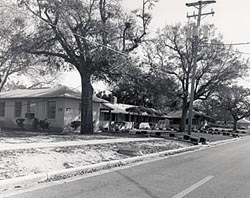
Eglin Air Force Base in Fort Walton Beach, Florida, has made major contributions to the defense of the United States in the development of tactical strategies, testing of weaponry and missile research. Development of the military base began in 1933 when U.S. Army Air Corps officials from Maxwell, Alabama, initiated a search for a site suitable for a bombing and gunnery range. In 1935 the War Department acquired by lease 137 acres of land near Valparaiso on which to build an airport. Eglin eventually grew to be the largest Air Force base in the Western Hemisphere, and played an important role in World War II. It covers 724 square miles of land and 86,500 square miles of the Gulf of Mexico. There are more than 3,000 buildings on the base, of which 164 were built during World War II. The Eglin Field Historic District contains 20 buildings representative of that era. These buildings are distinguished by the structural clay tile used in their wall construction. The administrative buildings and residences are rectangular in form, capped by shallow-pitched roofs and lack ornamentation. Common plans for wartime buildings, the urgency of wartime, local environmental conditions, and the availability of construction materials, dictated the design of Eglin's buildings. Some of the family housing quarters in the district display architectural characteristics related to the Minimal Traditional style, which reflects the transition from the earlier pre-War Tudor and Colonial Revival styles and the post-war Ranch style.

During World War II, Eglin Field served as the nation's principle station for air warfare experimentation. Accelerated aircraft and armament tests began in September 1941, three months before Pearl Harbor. In May 1941, the Army Air Corps designated Eglin as the Air Corps Proving Ground, removing it from the jurisdiction of the Southeast Air Corps Training Command and placing the base immediately under the control of the Chief of Air Corps. It was at Eglin Field that Lt. Col. James "Jimmy" Doolittle's B-25 crews from the 89th Reconnaissance Squadron and 17th Bombardment Group practiced short-field take-offs in preparation for the carrier-based raid on Tokyo on April 18, 1942. Although the damage the bombs inflicted was relatively small, the psychological effect on the Japanese was significant and America's resolve was strengthened. The primary purpose of the Proving Ground was to provide a station for tactical tests of aircraft armament and accessory equipment and of aviation tactics and techniques. Also, it was here, that final tests of the B-17, the workhorse of the allied air effort against Nazi Germany, were completed and evaluations of the B-29, which was to be employed against the Japanese isles, were initiated. Charles Lindbergh accompanied a flight from Eglin Field January 21, 1944, in an experimental XB-29, which had arrived at the base for tests. The crew of the flight included 1st Lt. F.A. Lewis and Lt. Col. Paul Tibbets, who flew the Enola Gay, which dropped the first atomic weapon on Hiroshima, Japan, and Charles Sweeney, who flew in the B-29 that dropped the second atomic weapon upon Nagasaki. By late 1944, development of a U.S. version of the German V-1 missile had begun at the proving grounds. During the war, it became apparent to military planners that America needed armaments and materials that could function in all climates and under all circumstances. To meet this need, the United States designed and constructed the McKinley Climatic Laboratory at Eglin.
Visit the National Park Service Travel American Aviation to learn more about Aviation related Historic Sites.
Last updated: August 29, 2017
